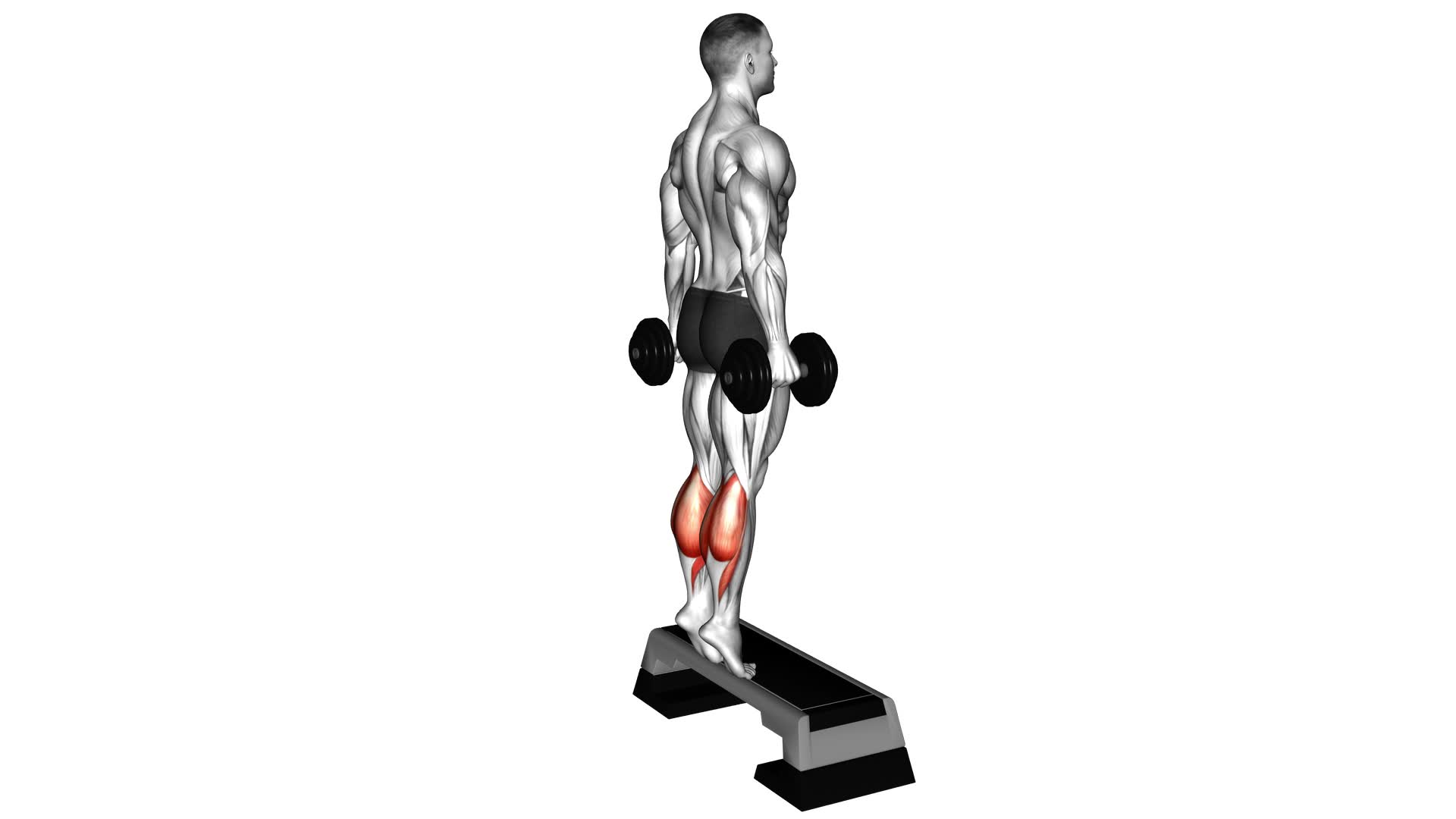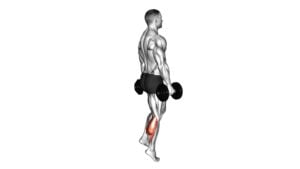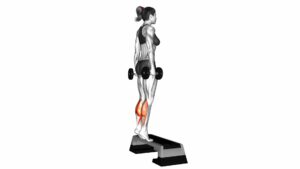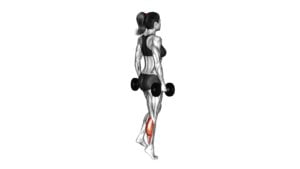Dumbbell Standing Calf Raise – Video Exercise Guide & Tips

Are you looking to strengthen and tone your calf muscles? Look no further than the dumbbell standing calf raise.
Watch This Exercise Video
This exercise is a great way to target your calves and increase their definition. All you need is a set of dumbbells and a little bit of space.
In this article, we'll guide you through the proper form and technique, provide variations and progressions, and give you tips to maximize your results.
Let's get those calves working!
Key Takeaways
- Dumbbell standing calf raise targets the calves, improving their strength and shape.
- It helps in improving balance and stability by engaging muscles in the feet and ankles.
- The exercise strengthens the muscles that support the ankles, reducing the risk of injuries.
- Dumbbells provide increased resistance and versatility for better results and muscle development in the calves.
Benefits of Dumbbell Standing Calf Raise
The dumbbell standing calf raise offers you the opportunity to strengthen and tone your calf muscles effectively. This exercise has several benefits that make it worth incorporating into your workout routine.
Firstly, it specifically targets the calves, which are often overlooked in traditional leg exercises. By focusing on the calves, you can build strong and shapely lower legs.
Additionally, the dumbbell standing calf raise is an effective way to improve your balance and stability. As you lift the weight using your calves, you engage the muscles in your feet and ankles, which helps to enhance your overall coordination.
Moreover, this exercise can also help to prevent injuries by strengthening the muscles that support your ankles.
The effectiveness of the dumbbell standing calf raise lies in its ability to isolate and work the calf muscles directly, leading to improved definition and strength.
Next, we'll discuss the equipment needed for this exercise, which is minimal and easily accessible.
Equipment Needed for This Exercise
To perform the dumbbell standing calf raise, you'll only need a pair of dumbbells. The equipment needed for this exercise is simple and accessible, making it convenient to incorporate into your workout routine.
Here are the benefits of using dumbbells for calf raises:
- Increased resistance: Dumbbells allow you to add resistance to your calf raises, making the exercise more challenging and effective in building strength and muscle in your calves.
- Improved balance and stability: Holding dumbbells in your hands while performing calf raises can help improve your balance and stability, as you need to engage your core and maintain proper form throughout the exercise.
- Versatility: Dumbbells offer various options for calf raises, allowing you to target different parts of your calves. You can perform standing calf raises, seated calf raises, or even single-leg calf raises, depending on your fitness level and goals.
By using dumbbells for calf raises, you can enhance the effectiveness of your calf workout and achieve better results. Incorporating different variations of calf raises with dumbbells can help you target specific areas of your calves and improve your overall calf strength and definition.
Proper Form and Technique
To perform the dumbbell standing calf raise with proper form and technique, focus on maintaining a stable position and engaging your calf muscles throughout the exercise. This exercise targets the calf muscles, which are composed of the gastrocnemius and soleus muscles. The gastrocnemius muscle is the larger muscle that gives the calf its rounded shape, while the soleus muscle lies beneath it and helps with ankle stability.
Before starting the exercise, it's important to warm up the calf muscles with stretching exercises such as calf raises or toe touches. To begin the standing calf raise, stand with your feet shoulder-width apart, holding a dumbbell in each hand. Keep your core engaged and your back straight. Rise up onto the balls of your feet, lifting your heels as high as possible. Pause for a moment at the top of the movement, then slowly lower your heels back down to the starting position. Repeat for the desired number of repetitions.
By focusing on maintaining stability and engaging your calf muscles throughout the exercise, you can maximize the effectiveness of the dumbbell standing calf raise.
Now let's move on to variations and progressions of this exercise.
Variations and Progressions
To progress and challenge yourself further, there are several variations of the dumbbell standing calf raise that you can incorporate into your workouts. These variations target different parts of your calf muscles and help in increasing calf strength.
Here are three different calf exercises you can try:
- Single-Leg Dumbbell Standing Calf Raise: Instead of using both legs, perform the exercise on one leg at a time. This variation adds an extra challenge as it requires more balance and stability.
- Seated Dumbbell Calf Raise: Sit on a bench with a dumbbell resting on your thighs. Place your feet on a platform with your heels hanging off the edge. Raise your heels as high as possible, then lower them back down. This variation specifically targets the soleus muscle in your calves.
- Explosive Dumbbell Standing Calf Raise: Instead of raising your heels slowly, perform the exercise explosively by pushing off the ground as forcefully as you can. This variation increases the intensity and power of the exercise.
Incorporating these variations into your routine will help you target different areas of your calf muscles and continue to challenge yourself, leading to increased calf strength.
Common Mistakes to Avoid
Avoid making these common mistakes when performing the dumbbell standing calf raise exercise. Proper technique is crucial to maximize the benefits and prevent injuries. One common mistake isn't using the correct weight. Using too heavy or too light dumbbells can negatively affect the exercise's effectiveness. It's important to choose a weight that challenges your calf muscles without compromising your form.
Another mistake to avoid isn't maintaining proper posture. Keep your back straight, shoulders back, and core engaged throughout the exercise. This helps to target the calf muscles more effectively and prevents strain on the lower back.
Not completing the full range of motion is another common mistake. Make sure to raise your heels as high as possible and lower them until your calves are fully stretched. This ensures that you're fully engaging the calf muscles and maximizing the exercise's benefits.
Lastly, rushing through the exercise is a common mistake that should be avoided. Take your time and focus on the contraction and extension of the calf muscles. Slow and controlled movements allow for better muscle activation and prevent unnecessary strain.
Tips for Maximizing Your Results
To maximize your results with the dumbbell standing calf raise, it's important to focus on proper form techniques. This includes keeping your back straight, your core engaged, and your heels fully extended at the top of the movement.
Additionally, incorporating progressive overload by gradually increasing the weight or reps will help challenge your muscles and stimulate growth.
Proper Form Techniques
For maximum results with the dumbbell standing calf raise exercise, you should focus on maintaining proper form throughout the movement. Here are some tips to help you achieve this:
- Calf muscle activation: To effectively target your calf muscles, make sure to fully extend your ankles at the top of the movement. This will ensure maximum contraction and engagement of the calf muscles.
- Stretching the Achilles tendon: As you lower your heels, allow your ankles to flex and stretch. This will help to stretch and strengthen the Achilles tendon, which is important for overall ankle mobility and stability.
- Keep your core engaged: To maintain balance and stability, it's crucial to engage your core muscles throughout the exercise. This will help you stay upright and prevent any unnecessary strain on your lower back.
Incorporating Progressive Overload
To maximize your results with the dumbbell standing calf raise, incorporate progressive overload techniques into your training regimen.
Progressive overload is the gradual increase in the intensity, volume, or frequency of your workouts to keep challenging your muscles and prevent plateaus. Overcoming plateaus is crucial for continual progress and achieving your fitness goals.
One way to implement progressive overload is by gradually increasing the weight of the dumbbells used in the exercise. Start with a weight that challenges you but allows you to maintain proper form. As you get stronger, gradually increase the weight to continue challenging your calf muscles.
Another important aspect of progressive overload is tracking your progress. Keep a record of the weight used, sets, and reps performed to ensure you're consistently pushing yourself and making progress.
Frequently Asked Questions
How Many Reps and Sets Should I Do for the Dumbbell Standing Calf Raise?
To determine the number of reps and sets for the dumbbell standing calf raise, consider your fitness goals and current strength level. Start with 3 sets of 10-12 reps to build strength and endurance.
As you progress, you can increase the number of sets or reps. Remember to listen to your body and adjust the weight accordingly.
Consult with a fitness professional for personalized guidance.
Can I Perform the Dumbbell Standing Calf Raise Without Using Dumbbells?
Yes, you can perform the dumbbell standing calf raise without using dumbbells. There are alternative ways to target your calf muscles, such as using a resistance band or performing bodyweight calf raises.
While using dumbbells adds extra resistance and can help increase the intensity of the exercise, you can still benefit from the standing calf raise without them.
It's important to focus on proper form and gradually increase the difficulty as you progress.
Is It Normal to Feel a Burning Sensation in My Calves During the Exercise?
Feeling a burning sensation in your calves during the calf raise exercise is normal. It indicates that you're effectively targeting and engaging your calf muscles.
The burning sensation is a result of the muscles working hard and the buildup of lactic acid.
To reduce discomfort, make sure you're using proper calf raise technique, such as keeping your core engaged, maintaining a slow and controlled movement, and not overloading with excessive weight.
Can I Incorporate the Dumbbell Standing Calf Raise Into My Leg Day Routine?
Yes, you can definitely incorporate the dumbbell standing calf raise into your leg day routine. It's a great exercise for targeting your calf muscles and can be done with dumbbells for added resistance.
The standing position helps to engage your core and improve balance. The benefits of standing calf raises include strengthening your calves, improving ankle stability, and enhancing your overall lower body strength.
Are There Any Modifications for Individuals With Knee or Ankle Injuries?
If you have knee or ankle injuries, there are modifications you can make to the dumbbell standing calf raise exercise. Instead of using dumbbells, you can use a resistance band to reduce strain on your joints.
This exercise is great for overall leg strength because it targets the calf muscles. By performing this exercise, you can strengthen your calves, improve ankle stability, and increase your overall leg power.
Conclusion
In conclusion, the dumbbell standing calf raise is a beneficial exercise for strengthening the calf muscles. By using dumbbells, you can increase the resistance and challenge your muscles even more.
It's important to maintain proper form and technique to avoid any injuries and get the most out of this exercise. Remember to start with lighter weights and gradually progress to heavier ones as you get stronger.
With consistent practice and proper execution, you can maximize your results and improve your calf strength and definition.

Author
Years ago, the spark of my life’s passion ignited in my mind the moment I stepped into the local gym for the first time. The inaugural bead of perspiration, the initial endeavor, the very first surge of endorphins, and a sense of pride that washed over me post-workout marked the beginning of my deep-seated interest in strength sports, fitness, and sports nutrition. This very curiosity blossomed rapidly into a profound fascination, propelling me to earn a Master’s degree in Physical Education from the Academy of Physical Education in Krakow, followed by a Sports Manager diploma from the Jagiellonian University. My journey of growth led me to gain more specialized qualifications, such as being a certified personal trainer with a focus on sports dietetics, a lifeguard, and an instructor for wellness and corrective gymnastics. Theoretical knowledge paired seamlessly with practical experience, reinforcing my belief that the transformation of individuals under my guidance was also a reflection of my personal growth. This belief holds true even today. Each day, I strive to push the boundaries and explore new realms. These realms gently elevate me to greater heights. The unique combination of passion for my field and the continuous quest for growth fuels my drive to break new ground.







